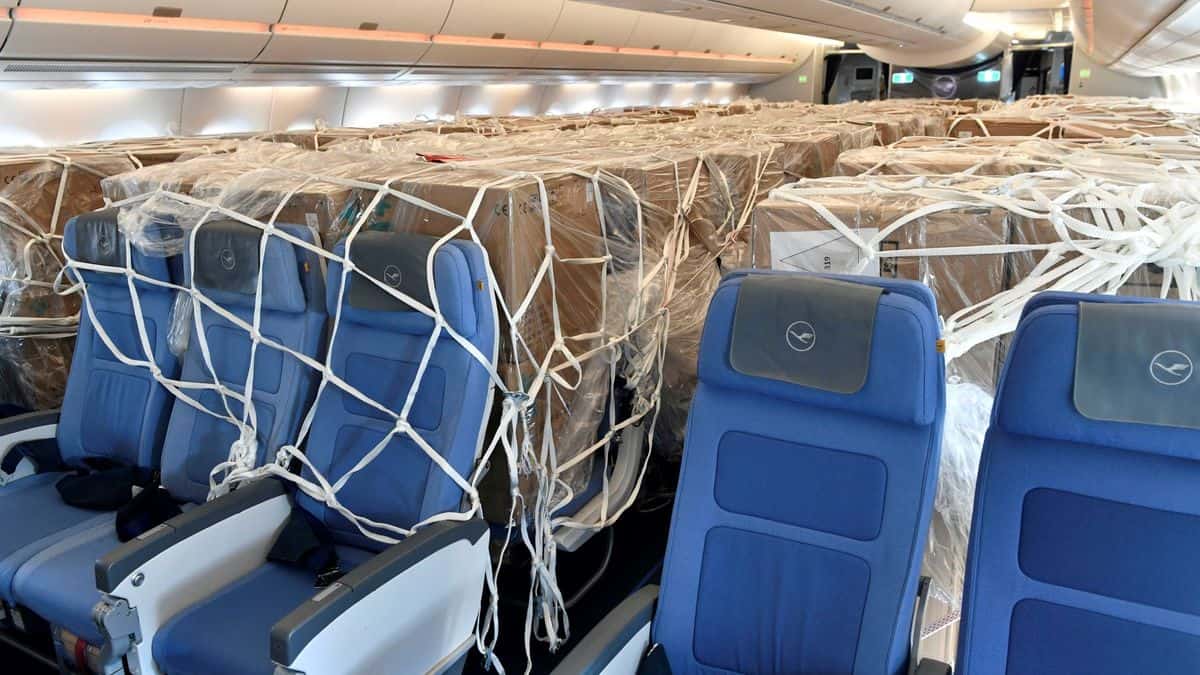U.S. airlines will soon fly temporary freighters with cargo, instead of passengers, in the seats.
Since domestic passenger carriers began operating some aircraft in cargo-only mode two months ago, they have been largely restricted to loading freight in the lower hold where baggage and shipments normally ride. On Thursday, the Federal Aviation Administration issued an exemption allowing airlines to carry cargo on seats.
Airlines had requested a two year break from existing regulations, but the FAA said the exemption is only valid through the end of 2020. The petition was filed by Airlines for America (A4A) on behalf of its members, so interested carriers must still submit a letter of intent and receive specific authorization from the agency.
The FAA determined the exemption was justified to ensure critical shipments for the COVID-19 response are not delayed at a time when most passenger flights have been suspended, creating severe capacity shortages for freight. Permitting the use of seats to increase aircraft efficiency “supports the sustainment of this critical component of the U.S. transportation infrastructure during the public health emergency and while passenger demand remains depressed, which may persist past the public health emergency,” the decision said.
There is too much market uncertainty at the moment to grant regulatory relief beyond Dec. 31, the FAA said, adding it will consider an extension at a later date depending on conditions.
The FAA has yet to rule on a separate A4A petition for permission to remove seats from passenger aircraft and load cargo on the floor.
More than 150 airlines around the world are using “ghost” freighters — no passengers, just cargo — in some form, according to industry experts. International aviation authorities have been quicker than the FAA to authorize cabin modifications for cargo. Many airlines have been loading cargo in seats for several weeks. Others, such as Icelandair, Lufthansa, Air Canada and Virgin Atlantic, have already made many flights with passenger seats removed.
Industry officials say using the seats adds about 30% more volumetric capacity, and six to seven extra tons, for cargo flights compared with just the lower hold. That can be a significant benefit when so many shipments now involve lightweight goggles, gloves and other protective medical equipment.
However, not all flights are good candidates for cargo in the passenger cabin and some airlines don’t bother because loading is labor-intensive. Individual boxes must be handled and secured, in contrast to the lower deck, which has wide doors for palletized freight.
Last month, the FAA approved the use of overhead bins, storage closets and under-seat areas for storing boxes and mail pouches on cargo-only flights. United Airlines has begun using the stowage spaces for lightweight pieces. Delta Air Lines officials have previously expressed interest in putting cargo in seats and gutting interiors to make room for larger loads. As previously reported, Alaska Airlines is ready to implement flights with cargo in seats and American Airlines says it intends to make use of the cabin for cargo.
The FAA’s latest exemption comes with several conditions, including a weight limit of 50 pounds per seat and 20 pounds per space under a seat, extra fire extinguishers and at least two crew members riding in the cabin to detect any potential fire, and an empty row in twin-aisle planes to allow access to both sides.
In related news, Cathay Pacific last week said in its latest newsletter that it has received special approval from the Hong Kong Civil Aviation Department to use the passenger cabin to carry cargo. On Boeing 777 passenger jets, workers load via the passenger door using a catering truck to lift the boxes, then manually secure them into seats. The airline is also seeking approval to put cargo in the cabin of its Airbus fleet.
And earlier this month, Dubai-based Emirates said it started using stowage bins and seats of its Boeing 777-300 extended-range jets to optimize cargo operations.












MrBigR504
Hey, you’ve gotta maximize your hustle!